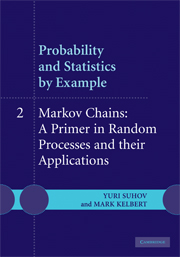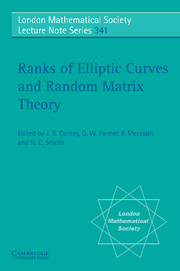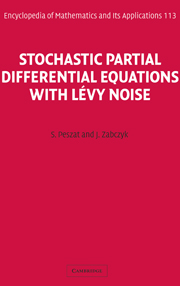Refine search
Actions for selected content:
3023 results in Probability theory and stochastic processes
Preface
-
- Book:
- Probability Theory
- Published online:
- 05 June 2012
- Print publication:
- 31 December 2010, pp xv-xxii
-
- Chapter
- Export citation
Chapter 2 - The Central Limit Theorem
-
- Book:
- Probability Theory
- Published online:
- 05 June 2012
- Print publication:
- 31 December 2010, pp 59-114
-
- Chapter
- Export citation
Index
-
- Book:
- Probability Theory
- Published online:
- 05 June 2012
- Print publication:
- 31 December 2010, pp 521-527
-
- Chapter
- Export citation
Chapter 11 - Some Classical Potential Theory
-
- Book:
- Probability Theory
- Published online:
- 05 June 2012
- Print publication:
- 31 December 2010, pp 456-516
-
- Chapter
- Export citation
Chapter 9 - Convergence of Measures on a Polish Space
-
- Book:
- Probability Theory
- Published online:
- 05 June 2012
- Print publication:
- 31 December 2010, pp 367-399
-
- Chapter
- Export citation
Chapter 8 - Gaussian Measures on a Banach Space
-
- Book:
- Probability Theory
- Published online:
- 05 June 2012
- Print publication:
- 31 December 2010, pp 299-366
-
- Chapter
- Export citation
Table of Dependence
-
- Book:
- Probability Theory
- Published online:
- 05 June 2012
- Print publication:
- 31 December 2010, pp xxiii-xxiv
-
- Chapter
- Export citation
Chapter 1 - Sums of Independent Random Variables
-
- Book:
- Probability Theory
- Published online:
- 05 June 2012
- Print publication:
- 31 December 2010, pp 1-58
-
- Chapter
- Export citation
Frontmatter
-
- Book:
- Probability Theory
- Published online:
- 05 June 2012
- Print publication:
- 31 December 2010, pp i-viii
-
- Chapter
- Export citation
Chapter 4 - Lévy Processes
-
- Book:
- Probability Theory
- Published online:
- 05 June 2012
- Print publication:
- 31 December 2010, pp 151-192
-
- Chapter
- Export citation
Chapter 5 - Conditioning and Martingales
-
- Book:
- Probability Theory
- Published online:
- 05 June 2012
- Print publication:
- 31 December 2010, pp 193-232
-
- Chapter
- Export citation
Chapter 3 - Infinitely Divisible Laws
-
- Book:
- Probability Theory
- Published online:
- 05 June 2012
- Print publication:
- 31 December 2010, pp 115-150
-
- Chapter
- Export citation
Notation
-
- Book:
- Probability Theory
- Published online:
- 05 June 2012
- Print publication:
- 31 December 2010, pp 517-520
-
- Chapter
- Export citation
Contents
-
- Book:
- Probability Theory
- Published online:
- 05 June 2012
- Print publication:
- 31 December 2010, pp ix-xiv
-
- Chapter
- Export citation

Probability and Statistics by Example
-
- Published online:
- 11 November 2010
- Print publication:
- 24 April 2008

Probability and Statistics by Example
-
- Published online:
- 11 November 2010
- Print publication:
- 13 October 2005

Ranks of Elliptic Curves and Random Matrix Theory
-
- Published online:
- 10 November 2010
- Print publication:
- 08 February 2007

Stochastic Partial Differential Equations with Lévy Noise
- An Evolution Equation Approach
-
- Published online:
- 10 November 2010
- Print publication:
- 11 October 2007
1 - Measure Theory
-
- Book:
- Probability
- Published online:
- 05 June 2012
- Print publication:
- 30 August 2010, pp 1-40
-
- Chapter
- Export citation
Reference
-
- Book:
- Probability
- Published online:
- 05 June 2012
- Print publication:
- 30 August 2010, pp 419-424
-
- Chapter
- Export citation
